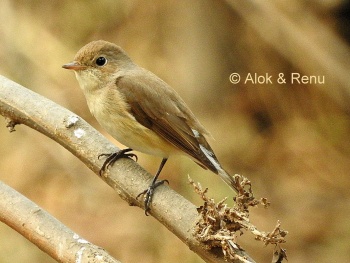- Ficedula parva
Identification

Photo © by Alok Tewari
Keoladeo National Park, Bharatpur, Rajasthan, India, 20 December 2018
11-12 cm (4¼-4¾ in)
- Ashy-brown upperparts, paler beneath
- Brown bill
- Dark brown legs
- Noticeable white patches at base of tail
Male
Bright reddish-orange throat and upper breast
Female and Juvenile duller brown above and whitish below
Similar species
Taiga Flycatcher has red only on throat and a grey breast.
Distribution
Europe, to southern Urals, Balkans and southern Caspian; winters to southern Asia.
Taxonomy
This is a monotypic species.
It formerly included Taiga Flycatcher as a subspecies.
Habitat
Deciduous woodland near water.
Behaviour
Action
Flycatches from perch, and will also 'glean' warbler-like amongst leaves.
Often flicking and cocking tail and sits with 'drooping wings'
Breeding
An open nest in a tree hole is built and 4-7 eggs are laid.
Diet
It feeds by taking insects in flight and caterpillars from among oak leaves. It also eats berries.
Vocalisation

Photo © by Alok Tewari
Dwarahat, Alt. 4800 ft., Dist. Amora, Uttarakhand Himalayas, India, 9 October 2017
References
- Clements, J. F., T. S. Schulenberg, M. J. Iliff, D. Roberson, T. A. Fredericks, B. L. Sullivan, and C. L. Wood. 2018. The eBird/Clements checklist of birds of the world: v2018. Downloaded from http://www.birds.cornell.edu/clementschecklist/download/
- Birdwatchers Pocket Guide ISBN 1-85732-804-3
- Collins Pocket Guide to British Birds 1966
- Collins Field Guide 5th Edition
Recommended Citation
- BirdForum Opus contributors. (2025) Red-breasted Flycatcher. In: BirdForum, the forum for wild birds and birding. Retrieved 13 May 2025 from https://www.birdforum.net/opus/Red-breasted_Flycatcher
External Links
GSearch checked for 2020 platform.1





